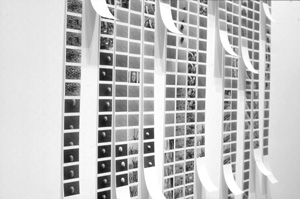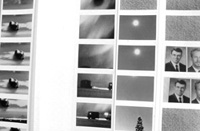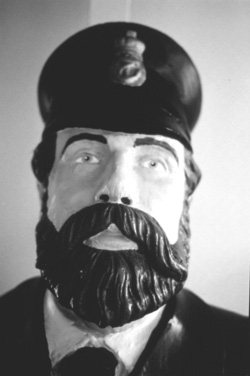|
|
From its inception photography was predicted a boon to the traveler. This prediction was soon borne out in the work of photographers such as Maxime Du Camp, whose antique and exotic Egypt unfolded in the laps of arm-chair voyagers. Locally, Leonard Frank’s early 20th-century photographs presented west coast forests as spectacular, inexhaustible and mostly empty. Many followed Frank into the woods, including location scouts. It might be said that west coast forests have been partitioned and clear-cut twice—once with cameras. Marker of discovery and tool for recollection, the travel photograph facilitates remembrance through dismemberment. What are expansive vistas but bits, sections, fetishes?
As such, present-day photographic tourism is also a tourism of photography and generic representations of such concepts as vista and wilderness. This notion of "wilderness" is tied to economic speculation (the photograph one commodity alongside softwood lumber, salmon, eco-tourism) and narratives of empire and nation. The image of the land once proving Canada a colonial asset is now a cache of Canadianness: Canadian nature resisting American culture. Hence Margaret Atwood’s Survival found basis for a Canadian literature in our beleaguered outpost-in-the-wilderness mentality. Parallel to this narrative of nationhood and communal belonging is the story of the lone wanderer, the romantic photo-tourist searching out visions of the sublime.
Two recent series of work by Gavin Hipkins address such imaginaries of travel and community. These mythologies, of ur-wilderness, of wanderlust and pioneer spirit, of deeply rooted group identification are elaborated in Hipkins’ work through the still photograph and its fetishising proclivities. In the works The Homely and The Next Cabin, Hipkins adopts the role of archetypal tourist, finding land and cityscapes presented for and groomed by the camera: physically and conceptually demarcated into bits functioning as memorial, photo-op, place of pilgrimage. These works are displayed as friezes of multiple prints, recording Hipkins’ travels through environments saturated with myth. In The Next Cabin (2000-ongoing), Hipkins’ journeys into "the wilderness" reconfigured as nostalgic haven, preserved in key places from the transience and even menace of the city-wilderness. This imaginary site coalesces in the figure of "Cascadia," an erstwhile, hypothetical nation roughly corresponding to the Pacific Northwest. Cascadia’s homogenous and unmediated local culture looms just out of frame in Hipkins’ photographs: a Bali Hai over the next ridge, in the next cabin. Paintings and carvings of ships and sea-captains found along Hipkins’ trail speak less to local maritime history than to a packaging of the area for travelers; everything is homely and handmade yet somehow generic. Barthes punctum, that piercing private identification with the photograph, is recast as a vague recognition of Captain Highliner in a carved figurehead.

|
|
Gavin Hipkins, The Mill (Garden) (detail), 2001
|
The strangeness of such experiences of identification, where the generic or even corporate emerges within the private, is alluded to in the title of Hipkins’ earlier series The Homely (1997-2000) and its reference to the Freudian uncanny. Set in New Zealand and Australia, the series contains images in which natural and social history reveals itself as grubby spectacle suffused with melancholy, humour and pathos. Stuffed birds gaze across canvas vistas, storybook paths and grottos unfold before the visitor. Many of the photo opportunities encountered seem less discoveries of the traveler than scenarios of interpellation: places where tourist pictures must be taken. For all their chance, instinctive and improvised feel, these images appear serendipitous cliches. They read as such not only when they mimic tourist photography, but also when they mimic, for example, generic surrealist effects such as one photo of black, disembodied, hat-wearing heads. What makes this image of symbolic castration, colonial violence and death painful is the couching of its social critique within mimicry of Surrealism, identified historically with fetishization of the racial other. It is in this sense that these works might be described as a tourism of an exhausted, spent photography.
Hipkins’ recent series The Mill (2001) also concerns itself with generic natural sites mobilized within a mythology, this time one of popular anxieties regarding environmental trauma: subsections of the project include River, Farm, Storm, Flood. In these works the frieze structure of The Homely and The Next Cabin is replaced by clusters of full strips of developed prints, hung to create a streaming or cascading effect. The hanging strip format reconfigures the simple narrative of the frieze as a fatiguing, distracting image grid. Hipkins passes through wilderness experienced as a series of iconographic abstractions: bucolic and pastoral green land, pleasure haven of eco-tourism, commercial resource, doomsday vision.
Considering his work broadly, Hipkins’ tour also passes through the formal and rhetorical history of the photograph: as reportage, as uncanny magic, as tourism, as simulacral rephotography, as death, punctum, cut, fetish. The Mill, in particular, utilizes strategies of rephotography in an investigation of the relationship between photography and fetish. Photographic treks through vast landscapes are substituted with incremental journeys taken by Hipkins’ camera across the pages of picture books, swathes of coloured fabric and candies. Interspersed with images of farms, rivers, eco-disasters and anonymous bureaucrats are sugary eggs, licorice shafts and glistening gummis halfway between fishing bait and flaccid penises. Dollops of chocolate conjure human anuses as readily as cowpats. The wanderer finds bits of their body and the bodies of others along the trail, placebos and part-objects strewn throughout a sickly wonderland pictured through identical processes of abstraction and selected erasure.
 |
|
Gavin Hipkins, The Mill (Storm) (detail), 2001
|
The unedited filmstrips, records of Hipkins’ photographic scan across his close at hand subjects, appear a form of stalled cinema. As his camera scans objects they are extended, drawn out, smeared. Visual fatigue periodically sets in when viewing these works, as the eye looks for a safe resting point but is constantly pushed forward. If a particular fragment briefly fixes attention, the gaze is shortly drawn to the next slightly altered frame. This constant seepage from one bit to another reads as a forlorn hovering, reminiscent in tenor of Hipkins melancholic wandering in search of Cascadia. Able to conjure but never fix its fetishes, Hipkins’ camera seems more tired than he. The more images the camera produces, the more prominent become the thin white strips that divide them: little screens inviting projected narratives, asking to be filled in. White hinterlands demanding more photographs.
|
|
|

